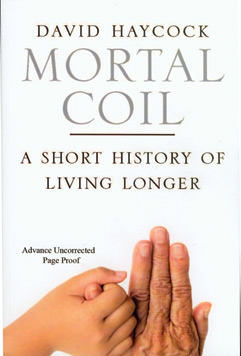BOOK REVIEW | Mortal Coil: A Short History of Living Longer
Review by Nathan Seppa
As Jonathan Swift once said, everyone wants to live forever, but no one wants to be old. Despite that snag, the question has lingered: Must we die so soon?

Some people have lived to be mighty old, and Haycock does them justice in this well-researched ramble through the pursuit of long life. Thomas Hobbes’ observation that life in the old days was “nasty, brutish and short” wasn’t entirely true. Europeans have shown an obsession with living longer, even publishing texts in the 1700s that mention people who lived a particularly long time. Among them: a French fellow who lived to see 121, a Dane who reached 145 and a Hungarian peasant who survived to 185. But documentation is fuzzy.
As living forever slipped from the grasp of philosophers and into the domain of medicine, early scientists talked about delaying the inevitable. But none did much about it until Louis Pasteur, Edward Jenner and Robert Koch came along and joined the battle against disease. Nowadays, the notion of living super-long through good nutrition and disease avoidance is back in vogue.
Genetics and advanced cell biology whet the appetite further. At first it seemed cells could live on and on. But it’s now clear that they can replicate only so many times before expiring. Still, biotechnology pursues eternal life. “Fear of old age and death will always drive at least some research in this subject,” Haycock says.
Meanwhile, the facts speak for themselves: The verifiably oldest person, the Frenchwoman Jeanne Calment, died in 1997 at age 122, and no one is close to breaking her record.
Yale Univ. Press, 2008, 320 p., $30.







